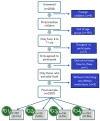Food Neophobia in Brazilian Children: A Nationwide Cross-Sectional Study Comparing Neurodivergent and Neurotypical Children with and Without Dietary Restrictions
- PMID: 40284192
- PMCID: PMC12030263
- DOI: 10.3390/nu17081327
Food Neophobia in Brazilian Children: A Nationwide Cross-Sectional Study Comparing Neurodivergent and Neurotypical Children with and Without Dietary Restrictions
Abstract
Objective: This study aims to compare food neophobia (FN) in groups of neurodivergent and neurotypical children with and without food restrictions. Methods: This cross-sectional study used a convenience sample of participants from all Brazilian Federative Units through the snowball method. Participants were separated into four groups for comparison: neurodivergent children without dietary restrictions; neurodivergent children with dietary restrictions; neurotypical children with dietary restrictions; and neurotypical children without dietary restrictions. The Brazilian Children's Food Neophobia Questionnaire (BCFNeo) was selected and administered to caregivers of Brazilian children between four and eleven years old. The categorization of FN scores followed a previously validated protocol. Results: The sample was composed of the caregivers of 2387 children. Considering the sample as a whole (neurodiversity), the prevalence of high FN was 44.2%. Boys are significantly more neophobic (p < 0.001) than girls. FN does not decrease with age. Older children (eight to eleven years) are equally neophobic as younger children (four to seven years). The prevalence of high FN was greater in neurodivergent children (without dietary restrictions-62.8% and with dietary restrictions-62.4%) than in neurotypical children (with dietary restrictions-29.4% and without dietary restrictions-33.4%). Conclusions: FN is more prevalent in boys and neurodivergent children, regardless of food restrictions and age. More longitudinal and experimental studies are necessary to evaluate the factors influencing FN in these groups and to develop intervention strategies.
Keywords: caregiver perception; child; food neophobia; food restriction; neurodiversity.
Conflict of interest statement
The authors declare no conflicts of interest.
Figures
References
-
- Volkmar F.R. Encyclopedia of Autism Spectrum Disorders. Encycl. Autism Spectr. Disord. Second Ed. 2021;2:5329.
-
- Mcgee M. Neurodiversity. SAGE J. 2012;11:12–13. doi: 10.1177/1536504212456175. - DOI
-
- Cleveland Clinic Neurodivergent. [(accessed on 15 December 2024)]. Available online: https://my.clevelandclinic.org/health/symptoms/23154-neurodivergent.
-
- Parliamentary Office of Science and Technology (POST) Support for Children and Young People. Parliamentary Office of Science and Technology (POST); London, UK: 2024.
Publication types
MeSH terms
Grants and funding
LinkOut - more resources
Full Text Sources
Miscellaneous


